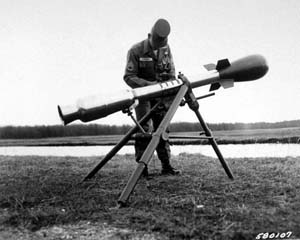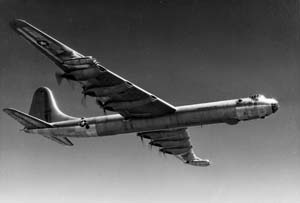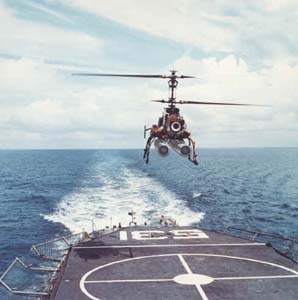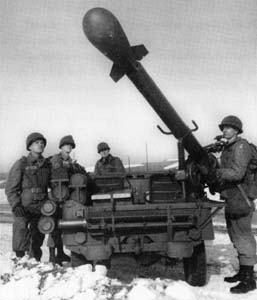By ?the time the Cold War reached its height in the late 1960s, the American nuclear arsenal had grown to more than 31,000 weapons. The Army, Navy, Air Force, and even the Marine Corps worked to acquire weapons for the “nuclear battlefield,” whether in the air, on the ground, on water, or underwater.
Three of the more unusual—and in the end impractical—of these weapons were the enormous Mk 17 hydrogen bomb, the Navy’s drone anti-submarine helicopter equipped with a nuclear depth charge, and the “Davy Crockett” atomic mortar-recoilless rifle.
When the first US atomic bombs were developed in World War II, there was some concern about whether they could be carried in aircraft, due to size. The “Little Boy” dropped on Hiroshima tipped the scales at 9,700 pounds, and the “Fat Man” dropped on Nagasaki weighed 10,300 pounds. The immediate follow-on bombs were about the same size or smaller.
 |
The “Davy Crockett,” shown here mounted on a tripod at Aberdeen Proving Ground in Maryland, was the smallest nuclear warhead ever developed by the US. ( DOD photo) |
However, the development of thermonuclear or hydrogen bombs led to much larger weapons, with the largest US nuclear weapon being the Mk 17 hydrogen bomb.
This thermonuclear weapon had a yield of 13.5 megatons—almost one thousand times more powerful than the Hiroshima explosion. The Los Alamos laboratory developed the Mk 17 at the end of a series of thermonuclear bombs initiated in 1950. This followed the Soviet detonation of an atomic bomb in 1949, several years before Western intelligence agencies expected such an event.
It was the era of “bigger is better.” The zenith of “big bombs” would be seen on Oct. 30, 1961, when the Soviet Union detonated (at Novaya Zemlya in the Arctic) a thermonuclear bomb that produced an explosion equivalent to 58 megatons—the largest man-made explosion ever achieved. Soviet Premier Nikita Khrushchev would later write in his memoirs: “It was colossal, just incredible! Our experts later explained to me that if you took into account the shock wave and radioactive contamination of the air, then the bomb produced as much destruction as 100 million tons of TNT.”
In the US, Gen. Curtis E. LeMay, commander of Strategic Air Command from 1948 to 1957 and later Air Force Chief of Staff, was a key advocate of big bombs. According to a SAC history, LeMay urged development of a 60-megaton bomb, claiming it would be useful to destroy hardened targets, have a deterrent value of its own because of large Soviet weapons, and be effective if deterrence failed because one “super” bomb could destroy targets that would require several lower-yield weapons.
 |
|
 |
|
The Lawrence Livermore National Laboratory provided SAC with proposals for 22,000-pound bombs that would have yields of 45 MT or 60 MT. Neither was developed, as critics claimed they had no realistic military value and could cause widespread nuclear contamination.
However, the Los Alamos National Laboratory’s proposed Mk 17 hydrogen bomb with a 15-MT yield was considered a practical weapon.
The Mk 17 was 24 feet, eight inches long and five feet, 10 inches in diameter. It was the second most powerful nuclear weapon to be developed and deployed by the United States. The Mk 17 design was successfully tested on May 4, 1954, during the Operation Castle series of nuclear tests at Bikini Atoll in the South Pacific. Its estimated yield was 13.5 MT.
The bomb entered the US inventory in May 1954 with about 200 weapons produced. It was followed into the inventory a few months later by the similar B24 thermonuclear bomb, with a similar predicted yield of 10 to 15 MT. The B24 was never tested, but a total of 105 bombs were produced.
Although never dropped in combat, a Mk 17 was once dropped inadvertently in New Mexico.
On May 22, 1957, one of the bombs was being transported to Kirtland AFB, N.M., in Albuquerque. Approaching Kirtland, the B-36 Peacemaker bomber hit turbulence at 1,700 feet while the Mk 17 was being secured for landing. The turbulence caused the 21-ton bomb to fall, carrying away the bomb bay doors.
Its parachute did not fully deploy, and the bomb struck the ground in an open field. The conventional high explosive within detonated, creating a crater 25 feet in diameter and 12 feet deep. Fortunately, the plutonium capsule—on board the aircraft—had not been inserted, thus there was no nuclear explosion. The mishap was one of 32 confirmed US nuclear weapons accidents—”Broken Arrows”—between 1950 and 1980.
The Mk 17 and B24 were in service for brief periods, until 1957 and 1956, respectively. Their size restricted them to being carried only by the giant B-36 Peacemaker. By the mid-1950s, the B-36 was being phased out of the nuclear strike role in favor of the B-52 Stratofortress and B-47 Stratojet, while smaller, more efficient nuclear weapons were being produced for those aircraft and for fighter and attack aircraft.
At the other end of the nuclear weapons spectrum was the Davy Crockett—a battalion-level weapon intended to provide US Army infantry units with an effective weapon against Soviet armored forces.
It was a recoilless rifle that could be fired from a light vehicle or from a tripod mount on the ground. The rifle fired a projectile 30 inches long, 11 inches in diameter, and weighing 76 pounds. Its warhead produced a yield in the 10- to 20-ton range (.01 to .02 KT). This was a smaller yield than predicted for the other applications of the W54 warhead, in the Falcon air-to-air missile or the Special Atomic Demolition Munition (SADM).
The weapon was tested twice in 1962, with live nuclear rounds producing estimated yields of 22 and 18 tons. The second test, on July 17, 1962, was witnessed by Attorney General Robert F. Kennedy and Gen. Maxwell D. Taylor, then a White House advisor and subsequent Chairman of the Joint Chiefs of Staff. It proved to be the last atmospheric nuclear test at the Nevada Test Site.
Two versions of the recoilless rifle could fire the nuclear warhead: a 120 mm weapon with a range of 6,650 feet, and a 155 mm weapon with a range of 13,125 feet. These ranges (less than three miles in all cases)—coupled with the lengthy process for obtaining release authority for nuclear weapons, especially in a combat environment where radio communications could be interrupted or denied—raised questions about the practicality of the Davy Crockett.
 |
A remotely operated DASH comes in for a landing on the deck of a US Navy destroyer. Plans called for DASH to deliver a nuclear depth charge. ( Photo courtesy gyrodynehelicopters.com) |
Still, with the massive proliferation of nuclear weapons, the Army persevered, and 400 nuclear rounds were produced for the system. It entered the inventory in 1961, and beginning in 1962, it was deployed with the US Seventh Army in West Germany and subsequently with Army units in Hawaii, Guam, Okinawa, and South Korea.
The withdrawal from service of the Davy Crockett began in July 1967, after six years in the inventory. The last weapons were retired in 1971. Its decade of service turned out to be much longer than the Mk 17 and B24 hydrogen bombs.
For the Navy’s part, one of the most unusual nuclear weapons systems of the Cold War was the Drone Anti-Submarine Helicopter (DASH). This was the only unmanned vehicle intended to carry a nuclear weapon—in this situation, a B57 nuclear depth bomb with a yield of about five KT.
By the late 1950s, the Navy was installing on ships the large AN/SQS-26 sonar, with an effective detection range beyond that of ship-launched, anti-submarine torpedoes or even rocket-assisted torpedoes.
The Trouble With DASH The British and Soviet navies were developing manned helicopters to exploit advanced shipboard sonar detections. The US Navy decided to develop an unmanned helicopter. It was hoped DASH could fly from smaller ships than could manned helicopters, operate in bad weather that would keep a manned helicopter on deck, and have higher readiness to launch in response to sudden sonar detection.
DASH was developed from the Gyrodyne firm’s one-man “Rotorcycle,” intended to carry a single marine and his equipment. The Marines had evaluated two XRON-1 and three YRON-1 prototype manned Rotorcycles, with the first XRON-1 flying in 1956. The DASH was to be a modification of the off-the-shelf RON-1 design, capable of carrying two Mk 44 anti-submarine, acoustic homing torpedoes, one Mk 46 torpedo, or a B57 depth bomb.
The helicopter had a range of some 35 miles, based on the range of a ship’s radar, needed for drone control. For a DASH mission, the drone was “piloted” during takeoff and landing by an officer at a console adjacent to the ship’s flight deck. During the mission, the drone was controlled by an officer in the ship’s combat information center who would “fly” the helicopter to the target area and release the weapon. No sensors were carried by DASH, and its endurance was just over two hours.
Gyrodyne was awarded a contract for the first unmanned DSN-1 helicopter on Dec. 31, 1958, but the first unmanned landing did not occur aboard ship until two years later. The definitive DSN-3 became operational in late 1962, redesignated QH-50C in the new joint designation system. These drones were deployed two per anti-submarine ship, beginning in January 1963 aboard the destroyer USS Wallace L. Lind. An improved QH-50D variant entered service in 1966.
In all, the Navy built or modified more than 200 destroyer-type ships and frigates to operate DASH. The procurement numbers were impressive—12 prototypes were followed by 732 QH-50C/D aircraft.
 |
The Davy Crockett nuclear weapon could be launched from either a light vehicle or a stable tripod. ( US Army photo) |
While DASH was deployed with anti-submarine torpedoes, no ships are known to have carried the planned nuclear depth charges. DASH was in operational service with the Navy for less than a decade: from November 1962 to January 1971. More than 400 DASH helicopters were lost in this period.
The large number of DASH casualties was due in large part to the Navy’s operational policies. To conserve the aircraft, destroyers that operated with aircraft carriers would not fly their helicopters en route to overseas areas. And because of problems with electronic interference, they could not fly their drones while the carriers were operating in forward areas.
Thus, during a typical six-month deployment, the ships rarely operated the drones, and this led to operators lacking flight experience. Furthermore, there was a desire not to risk the drones but to retain them in a high state of combat readiness.
Dropped from anti-submarine ships by 1971, the DASH helicopters did serve aboard a few US ships in the Vietnam War for gunnery spotting (equipped with television cameras), and were flown for several years by the Japanese Maritime Self-Defense Force.
No nuclear weapons were employed in combat during the 45 years of the Cold War, although tens of thousands were poised and ready for use.
In retrospect, many would have been “practical” in the terrible environment of nuclear conflict, but many others, including those described above, were not only impractical, but absurd in concept as well as in development.
This article is adapted from The US Nuclear Arsenal: A History of Weapons and Delivery Systems Since 1945, by Norman Polmar and Robert S. Norris. Polmar is a defense analyst and author in the Washington, D.C., area. Norris is senior research associate at the Natural Resources Defense Council in Washington, D.C. Polmar’s most recent article for this magazine was “Flights From the Deep,” in the March 2004 issue. This is Norris’ first article for Air Force Magazine.